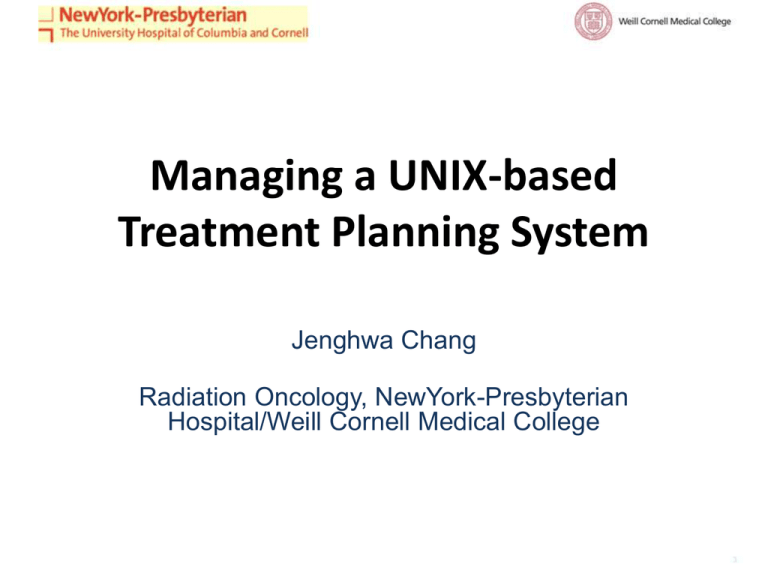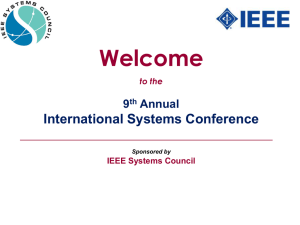Managing a UNIX-based Treatment Planning System Jenghwa Chang
advertisement

Managing a UNIX-based Treatment Planning System Jenghwa Chang Radiation Oncology, NewYork-Presbyterian Hospital/Weill Cornell Medical College System management: • • • • • • Policy and procedure System manager User management Privilege assignment Scripting Synchronize preferences • • • • • Killing processes Database integrity Backup and recovery, Plan locking Anonymizing patient data UNIX-like Operating Systems From Wikipedia, the free encyclopedia Pinnacle³ TPS • Manufactured by Philip Healthcare • A general purpose TPS for external beam RT and brachytherpy • Current version: 9.6 • Operating system-Solaris 10 bash-3.00$ uname -a SunOS nysgpinnapp0 5.10 Generic_142910-17 i86pc i386 i86pc • Management on two levels: – System level: need good knowledge of UNIX – Application level: very familiar with Pinnacle³ Challenges of Enterprise TPS-Security Concerns Treatment Planning Room Pinnacle at NYPH Enterprise servers at SunGard Data Center (NJ) 3 Gbs NYPH WCMC (upper east side) 1 Gbs Citrix Server NYPH CUMC (Washington Height) 1 Gbs 100 Mbs VPN Stich Radiation Center: 12 thin client Workstations Centralized Treatment Planning: 11 thin client Workstations PC access: 10 P3PC licenses Radiation Oncology: 17 thin client workstations Treatment Planning at NYPH • Treatment planning system: – Pinnacle 9.6 – ~40 Thin Client workstations – ~10 P3PC through Citrix • Technology – 3D, IMRT, VMAT – SRS, SBRT, IGRT • Patient load: 140 daily • Staff: – – – – – Planners: 7 Physicians: 14 Physicists: 14 Medical residents: 12 Physics residents: 5 • R&V: – Mosaiq – Electronic chart – QCL (quality control list) for flow control. System-level Management • Mainly performed by IT and vendor but it will be more efficient if you can perform: – User creation and deletion – Kill certain user process when necessary • You need to know: – How to telnet a UNIXlike system – A few UNIX commands – UNIX file structures – How to kill processes System Management-Application Level • • • • • Institutions Plans Physics Configuration Backup and Archive • Mainly performed by physicists/dosimetrists. • Requires clearly defined policy and procedures considering the clinical need and available manpower. Yes, we all joke about P&P but the reality is that… we need them to • Run the TP operation fairly, effectively and efficiently • Deal with many users, each with different personality and individual need. • Be prepared when there is an emergency. • Say NO to people with unreasonable requests. Avoid illogical and insane P&P! Identify problem Develop Enforce Discuss • Identify real problems • Discussion: get all (planner, physicist, physician…) part • Enforce: ask for the endorsement of higher-ups (e.g., chairman) if necessary. System Managers • Know the password for – Super user for Solaris OS for system level management – “Configure in Pinnacle for application level management • How many? – Too many raises security concern. – Too few might cause clinical inconvenience. – Negotiate with IT and find the optimal number. NYPH System Manager Policy • The Pinnacle system management team consists of: – – – – – Director of Centralized Treatment Planning (CTP). System manager for CTP. System manager for TDSI. System manager for Weill Cornell Medical Center (WCMC) campus System manager for Columbia University Medical Center (CUMC) campus • Each member of the Pinnacle system management team will be given the password for root login to perform the following tasks: – – – – Creation of user accounts. Management of the patient database. Backing up, restoring or transferring patients among institutions. Killing certain user processes when necessary. A system manager might be called anytime, anywhere so you will need … • Good knowledge of the operating system • Very familiar with TP software • VPN (virtual private network) allowing you to connect to the server from anywhere • Terminal emulator on your computer • Email and cell phone access 24/7 A Real-life Example Good old days: “p3rtp” “p3rtp” • Simple and convenient but – Almost anyone in this business can log into your system – Every mistake is made by p3rtp – Every plan is locked by p3rtp • Is acceptable only if – All workstations locked in a room. – Only planners have accessed Treatment Planning Room The single most important technique for TPS security is user control… • For enterprise TPS, universal login – Causes major security concerns – Is against the institution policy – IT wouldn’t allow it • Every user must – have His/her own account and – Login password – Change password periodically NYPH User Management Policy 1. Each user must have an individual login account. 2. A new user should contact the Pinnacle system managers to request an individual login account. 3. A new user account will be issued after the new user a. b. Goes through the orientation. Presents certificates for HIPPA pivacy and Security trainings. 4. Must change the password immediately, and should change the password periodically afterwards. 5. The individual login replaces the planner’s signature in a locked plan. Three Types of Institutions • Clinical institutions: – One for each campus – Contains approximately three months worth of clinical patient data • Archive institutions: – Patients planned from three months ago – Created monthly for each campus. – Short lived: archived after creation. • Research/training institutions: created for research or training purposes. Scripting-system level • UNIX commands are submitted to the Operating System via a (e.g., c, sh, bash…) shell • Script: a file containing UNIX shell commands is known as a (shell) script. • Very important for system manager: – – – – – User creation Kill a processes Synchronize preferences Privilege assignment Many other system-level management functions Scripting-application level • The same system-level shell scripting extensively used by Pinnacle TPS. • Very powerful tool for – Standardizing TP approach – Improving TP productivity • To take the most advantage: – Don’t just rely on Pinnacle – Know how to edit scripts – Familiar with the OS Useful UNIX References • UNIX commands – http://mally.stanford.edu/~sr/computing/basicunix.html – http://www.math.utah.edu/lab/unix/unixcommands.html • UNIX scripting – http://en.wikipedia.org/wiki/Shell_script – http://www.dartmouth.edu/~rc/classes/ksh/ Privilege Management • Use basic file permissions, i.e, “ugo” and “wrx”. • Every user has the same privilege except for superuser. • It is an ultimate crime if a regular user: • Delete a patient or • Move a patient from one institution to another • We cannot prevent the crimes but we can find the offenders Synchronize Preference • Pinnacle preference files: used to set default values s for various functions when Pinnacle starts • Why synchronize: to standardize the work environment for all users. How to synchronize? • Maintain the preference files for a standard user according to the TP P&P. • Synchronize: copy the preference files of the standard user to other user’s home directory. • Manual synchronization: impossible for > 80 users • User script to help Sometimes you have to kill…a process • When to kill and how to find the process: – – – – Session frozen: use “ps” Screen locked: use “ps” Plan opened by others: use “ptree” Hung process: use “Top” • How to kill: – Open an x-term – Log in super user – Use “kill -9 processno” • Remember to remind people: What is not saved will be lost… NYP Plan Locking Policy • Prior to printing out the plan, the treatment planner should lock the approved plan in the Pinnacle TPS. Why lock the plan? • Some non-planners like to “improve” the plan themselves • Prevents inadvertent change of the plan after approval • Replaces the planner’s signature: – Very useful for EMR – Need individual login Database Integrity • Patient data are stored as: – Database data: patient demographics, plan info, image set name and location… – System data files: images, plans, structures… • It is possible to delete system data without updating the database. • Fix: rebuild the database: – Immediately delete system data files – When you detect inconsistency between database and system data. – Periodically rebuild the database is NOT recommended for the enterprise system. Backup and Archive • Backup: – Periodic back up patient data – Purpose: to prevent data loss – Consideration: what to backup and frequency (daily, weekly or monthly) • Archive: – Remove the data from the system after the backup – Purposes: reduce system burden, speed up operation – Consideration: frequency (all patients in one month or every case?) Backup Mechanisms • Existing mechanisms: – RAID 5: part of the system – Remote data back: service provided by contractor (e.g., Sungard ) – Local back, i.e., DIY • Still need to local backup? “YES” because: – – – – RAID 5 may fail: we have experienced it It takes time to restore from remote backup Timely restore if needed Can retrieve an older version of a plan NYPH Backup Policy • Weekly : backup clinical institutions and research institutions being modified. • Monthly: backup all institutions. • Using the Pinnacle backup tool. • Data (tar files and index files) backed up to the Pinnacle backup directory and copied to a network drive. • Integrity of selected tar files tested after backup. NYPH Archive Policy • At the time an archive institution is created, it is backed up to – The archive directory in Pinnacle – The network archive drive. • The integrity of archive tested by restoring selected patients to Pinnacle. • The archive institution deleted. • The index files created for backup are kept for future restore. Why anonymizing patient data? • For patient data in research or training institutions. • Protect patient privacy if the data is used for non-clinical purposes. • HIPPA requirements. • For federal funded research project, the patient data must be anonymized. Anonimization • Two step process: – Anonymize the database data – Anonymize data files • Database data: – Straightforward. – Change the patient demographics directly. • Data files: – Tricky. – Call Pinnacle to get the instructions for your Pinnacle version. • You might need to rebuild the database.


